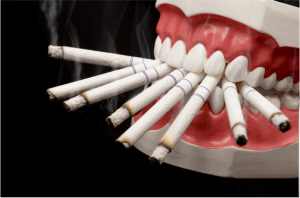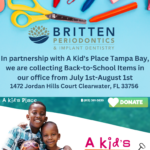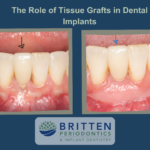“There’s more to your dental visit than just preventing or treating teeth or gum problems,” states Clearwater Periodontist Dr. Todd Britten. Dental professionals are also on the lookout for a number of potential soft tissue problems that could occur in or around your mouth. “There are many soft tissue conditions of the mouth that we evaluate for during a periodontal or general dental examination, but one of our biggest growing concerns is oral cancer,” says Dr. Britten.
In the last 10-15 years, a type of cancer affecting the head and neck has snowballed. That threat is human papillomavirus, or HPV. This cancer is often found on the tongue, mouth or throat and is caused by the human papillomavirus HPV type 16, which is the same high-risk HPV that causes cervical cancer.

https://brittenperio.com/wp-content/uploads/2019/02/gI_142627_hpv-074747_Instagram-1.png
An April 2017 data brief released by the Centers for Disease Control and Prevention (CDC) shows the prevalence of HPV of all types was 7.3% among U.S. adults ages 18 to 69. Four percent of that population carries the high-risk HPV.1
“Most types of oral HPV go away before they cause any health issues,” Britten says. He explains that if a patient develops oral warts, also known as an oral papilloma due to HPV, it can be removed by surgical removal, cryotherapy, which is where the wart is frozen, or interferon alfa-2B (Intron A, Roferon-A), which is an injection.
Although most people who are exposed to the virus clear it, the virus can remain persistent. “Those who are unable to clear it end up having a risk of developing the oral form of this cancer,” says Dr. Richard Jordan D.D.S., Ph.D, professor of Oral pathology, Pathology and Radiation Oncology, University of California San Francisco, who recently presented “HPV: An old foe in a new form” at the March 2017 American Academy of Dermatology (AAD) annual meeting in Orlando, Fla.
“Most of the people that have this virus persisting in their bodies probably picked it up 20 years ago, when they first become sexually active. The virus makes a home in their throats or tongues, sits there for 20 years and eventually develops into cancer in their 40s or 50s,” he says. “This is actually the same story as with the cervix in women… Most women get rid of the virus, but some are unable to clear the virus. They’re the ones that end up getting in trouble with cervical precancers.”
The number of people impacted by the oral cancer due to HPV is growing, but due to regular pap smears, cervical cancer rates have declined. Dr. Richards projects that by 2030 there will be more patients per 100,000 with mouth cancer due to HPV, compared to cervical cancer.
Dr. Todd Britten states that this leads us to believe that dental specialists such as restorative dentists, periodontists, and dental hygienists, who often see their patients for preventative or periodontal maintenance visits anywhere from every 3 to 6 months, are in the perfect position to screen for oral cancer in the hopes of catching it in its precancerous stages.
In under 30 seconds, your dental professional will scan the oral cavity for abnormalities. HPV disease mostly occurs in the tongue and in the tonsil region, so examining the tongue, the sides of the tongue and the base of the tongue and the tonsillar region. An oral cancer screening, including the HPV screening exam includes looking for an ulcer or an abnormal growth. “Patients should also do an at-home screening monthly using a flashlight, and report any sores or growths that seem unusual and do not go away by themselves in two weeks, or constantly reoccur,” says Dr. Todd Britten. If an abnormal growth is detected, Dr. Britten says he is able to perform some biopsies in his Clearwater Florida practice, and when necessary, refer to an oral surgeon.
Sometimes, infection with HPV in the oral cavity has no evidence of sores or growth. Early symptoms of oropharyngeal cancer include trouble swallowing, constant earaches, coughing up blood, unexplained weight loss, enlarged lymph nodes constant sore throats, lumps on the cheeks, growths or lumps on the neck, hoarseness or trouble speaking.
If you notice any of these symptoms and you know or think you may have HPV, make an appointment with your doctor immediately.
Treatment options are available for oral cancer caused by HPV. The treatment and prognosis depend on the stage and location of the cancer and whether or not it’s associated with HPV. Treatment for cancer caused by HPV can include radiation therapy, surgery, chemotherapy, or a combination of these. The good news is HPV-positive oropharyngeal cancers have better outcomes and fewer relapses after treatment than HPV-negative cancers.
Dr. Richard Jordan also reports that non-smokers respond very well to radiation treatment for HPV oral cancers, while unfortunately, smokers tend to have fairly aggressive disease and a poor five-year survival rate, according to Dr. Jordan.
“After five years, about 60% will be dead; about 40% will be alive,” he says. “HPV responds very well to currently available cancer therapies. If the patient doesn’t smoke, the five-year survival rate is extraordinarily high—at 80 or 90%.”
A periodontist is mainly concerned with diagnosing and treating soft tissue problems. Some soft tissue conditions include Lichen Planus, Benign Mucous Membrane Pemphigoid, Geographic Tongue, Burning Mouth Syndrome, Apthous Ulcers and Oral Mucositis from Chemotherapy, among many others. “Oral cancer screenings are part of our regular soft tissue evaluation,” says Dr. Britten. We work with the finest general dentists and oral surgeons to catch any irregular, precancerous or cancerous conditions in our patients’ mouths.







